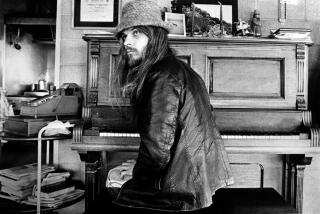‘Fred Neil’: New Attention for a Cult Figure
- Share via
No Fred Neil record has ever graced the nation’s pop charts, but you’ll often hear about him when some of the great singer-songwriters of the modern pop era talk about their influences.
“It was the voice that got you first . . . that honey-laden baritone with the Southern lilt,” Lovin’ Spoonful leader John Sebastian has said of Neil. “Fred Neil would slump over that mike with his big fat 12-string [guitar] and the walls would move. . . . Waitresses would melt in their tracks.”
And the voice was just the beginning, Sebastian points out in an appreciation contained in “The Many Sides of Fred Neil,” a two-disc retrospective of Neil’s work that has been released by Collectors’ Choice Music.
Neil’s best moments on record were also characterized by graceful writing and richly tailored arrangements that seemed to defy the conventional compromises of the pop world--musical touches that reached straight to the heart of human emotion and experience.
“Everybody’s Talkin’ ” is a record that might have made Neil a star, but it was a Harry Nilsson version of that Neil song that was used in the 1969 film “Midnight Cowboy,” and that exposure turned the Nilsson version into a Top 10 hit.
Even if Neil’s version had been used in the film, it’s not clear that it would have changed his career. Some admirers feel the reclusive singer-songwriter was born to be a cult hero--someone who, like Tim Hardin and Gram Parsons, ranks high on any list of America’s most underappreciated pop artists.
*
*** 1/2 Fred Neil’s “The Many Sides of Fred Neil” (Collectors’ Choice Music). Neil is a Florida native who got started in the record business early enough to co-write a song (“Come Back Baby”) that Buddy Holly recorded before his death in 1959, and another song (“Candy Man”) that was the flip side of Roy Orbison’s “Crying” in 1961.
Though Neil recorded assorted singles in the ‘50s, he didn’t reach his creative stride until the early ‘60s when he became active in New York folk clubs, where reportedly he was sometimes backed on harmonica by an admiring Bob Dylan.
The music on “The Many Sides” is drawn from his work on Capitol Records, where he teamed with producer Nik Venet. Together, they created what seemed like a new sonic universe, matching Neil’s gently introspective, soul-searching vocals and songs with textures that at once seemed aggressively contemporary (with their psychedelic touches) and virtually timeless (in their folk-blues base).
Neil’s self-titled Capitol debut was released in 1966 and contained songs, including “The Dolphins,” “Everybody’s Talkin’ ” and “I’ve Got a Secret (Didn’t We Shake Sugaree),” that showcased Neil at his best.
His second album, 1968’s “Sessions,” lacked the clarity and inspiration of the first; it sounded like the work of a man who was sinking into his own private musical world, with no interest in reaching a mass audience. There were occasional glimpses of the discipline and vision that made “Fred Neil” such a landmark work, but Neil’s gift was mostly diluted by aimless jams and noodling.
Neil’s final Capitol album, “Other Side of This Life,” was a mix of live versions of some of Neil’s best-known tunes and assorted studio tracks. The retrospective also includes a 1963 treatment of the Lefty Frizzell hit “Long Black Veil” that Neil and the Nashville Street Singers did in a clumsy, commercial folk style.
The bonus treat of “Many Sides” is six previously unreleased tracks, the best of which (notably the melancholy “December’s Dream”) convey the intensity and feeling of the “Fred Neil” period.
So what happened to Neil and the promise?
It’s a mystery that seems tucked away in southern Florida, where Neil has remained all these years, seemingly content to let the pop world pass him by. In the new set’s liner notes, Richie Unterberger says Neil has neither recorded nor toured since the Capitol years.
Whether or not it is too late for reaction to this retrospective to prompt Neil to return to the stage, the album should at least help a new generation of music fans understand why Neil was once held in such awe.
All a value-minded consumer really needs is the first Capitol album, but even Neil’s failures on this retrospective carry the arresting stamp of an artist in search of some personal truths.
More to Read
The biggest entertainment stories
Get our big stories about Hollywood, film, television, music, arts, culture and more right in your inbox as soon as they publish.
You may occasionally receive promotional content from the Los Angeles Times.










